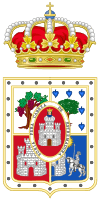San Pedro Manrique
| San Pedro Manrique | ||
|---|---|---|
| ||
 San Pedro Manrique Location in Spain | ||
| Coordinates: ES 42°1′N 2°13′W / 42.017°N 2.217°W | ||
| Country | Spain | |
| Autonomous community | Castile and León | |
| Province | Soria | |
| Comarca | Tierras Altas | |
| Government | ||
| • Mayor | Carlos Martínez Izquierdo | |
| Area | ||
| • Total | 176.20 km2 (68.03 sq mi) | |
| Elevation | 1,177 m (3,862 ft) | |
| Population (2009) | ||
| • Total | 626 | |
| • Density | 3.6/km2 (9.2/sq mi) | |
| Time zone | CET (UTC+1) | |
| • Summer (DST) | CEST (UTC+2) | |
| Climate | Cfb | |
| Website | Official website | |
San Pedro Manrique is a municipality located in the province of Soria, Castile and León, Spain. As of 2009, it had 626 inhabitants. Since mid-nineteenth century this municipality has aggregated smaller villages.


There is a deposit of lead in the municipality.[1]
Villages
- Acrijos
- Armejún
- Buimanco
- Fuentebella
- Vea
- Peñazcurna
- Valdemoro de San Pedro Manrique
- Villarijo
- Matasejún
- Valdelavilla
- Santiago
- Valdenegrillos
- El Vallejo
- Taniñe
- Las Fuentes de San Pedro
- Ventosa de San Pedro
- Palacios
Gallery
 SAN PEDRO MANRIQUE
SAN PEDRO MANRIQUE.jpg) Ruinas de la Iglesia románica de San Miguel (s.XIII).
Ruinas de la Iglesia románica de San Miguel (s.XIII)..jpg) Iglesia románica de San Martín de Tours (s.XII).
Iglesia románica de San Martín de Tours (s.XII). Ermita de la Virgen de la Peña (s.XIII).
Ermita de la Virgen de la Peña (s.XIII). Arquitectura rural de la zona.
Arquitectura rural de la zona. Centro urbano.
Centro urbano. Puerta de entrada de la Antigua muralla.
Puerta de entrada de la Antigua muralla. Una casona del pueblo.
Una casona del pueblo.
History
To the French revolution the town was a constitutional municipality in the region of Castilla la Vieja, Soria.[2] in the census of 1842 counted on 138 homes and 550 neighbors.
In the 19th century[3] the municipality incorporated
- Acrijos,
- Armejún,
- Buimanco,
- Fuentebella,
- Peñazcurna and
- Valdemoro de San Pedro Manrique and
- Villarijo.
At the end of the 20th Century the municipality incorporated[4]
- Matasejún with Valdelavilla.
- Sarnago with Valdenegrillos and The Vallejo.
- Taniñe, with the sources of San Pedro.
- Ventosa de San Pedro, with Palacios.
A January 1, 2010 the population was 639 inhabitants, 359 men and 280 women.[5]
Economy
The town is known for the Spicy sausage produced in San Pedro Manrique. The area is mainly reliant on livestock, agriculture, food industry (chacinera), hospitality, forestry and local services.
Folkculture
It is known for its unique celebration of San Juan. At parties, some women called "Móndidas" dressed in traditional costume wearing huge "cestaños" (a kind of basket filling stones for stability, and containing a roulade and several rolls), decorated with flowers and three "arbujuelos" (tree branches covered with unleavened bread colored with saffron). On the night of San Juan, known as the Paso del Fuego a bonfire next to the shrine of the Virgen de la Peña is lite and when it has burnt to embers, the natives remove their shoes and their feet tread the lighted embers. It is very possible that these parties are residue of a pagan pre-Christian holiday, and the name of móndida, come from Maenad. The event is classified as a place of ethnological interest by the Castile and Leon government.
In 2011, a scientific study of Paso Fire sparked global interest. In this study, the scientists showed an effect of the passage of fire to synchronize the heartbeat of practitioners and spectators.[6][7]

Landmarks
- Shrine of the Virgin de la Peña, (pictured)
- Romanesque church of San Miguel with statues of the Apostles
References
- ↑ Termalismo antiguo. Madrid: Universidad Nacional de Educación a Distancia, 1997, p. 269.
- ↑ Municipio Código INE -42. p165.
- ↑ Entre el Censo de 1970 y el anterior
- ↑ Entre el Censo de 1981 y el anterior
- ↑ http://www.ine.es/jaxi/tabla.do?path=/t20/e260/a2010/l0/&file=mun42.px&type=pcaxis&L=0.
- ↑ Konvalinka, I., Xygalatas, D., Bulbulia, J., Schjoedt, U., Jegindø, E-M., Wallot, S., Van Orden, G. & Roepstorff, A. 2011. "Synchronized arousal between performers and related spectators in a fire-walking ritual", ‘’Proceedings of the National Academy of Sciences 108’’(20): p8514-8519.
- ↑ Xygalatas, D., Konvalinka, I., Roepstorff, A., & Bulbulia, J. 2011"Quantifying collective effervescence: Heart-rate dynamics at a fire-walking ritual",Communicative & Integrative Biology 4(6): p735-738.
External links
- Fire-walking (Discovery Channel story on the fire-walking rituals of San Pedro Manrique) from Discovery Channel (Canada)

